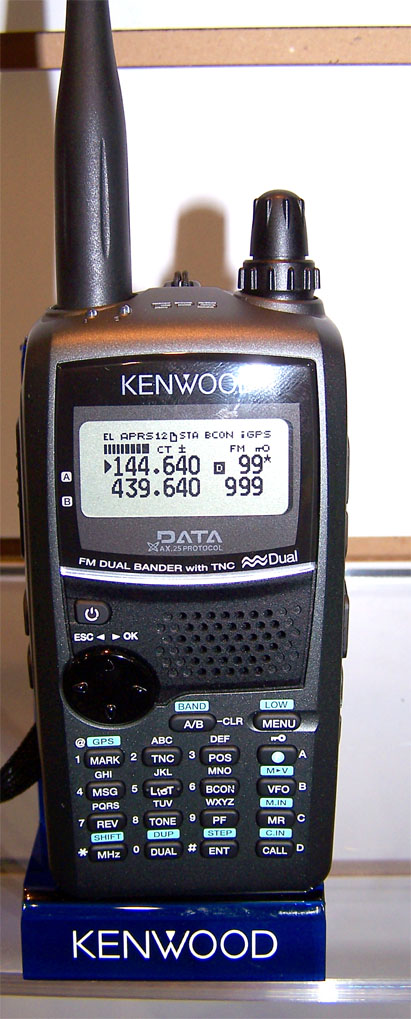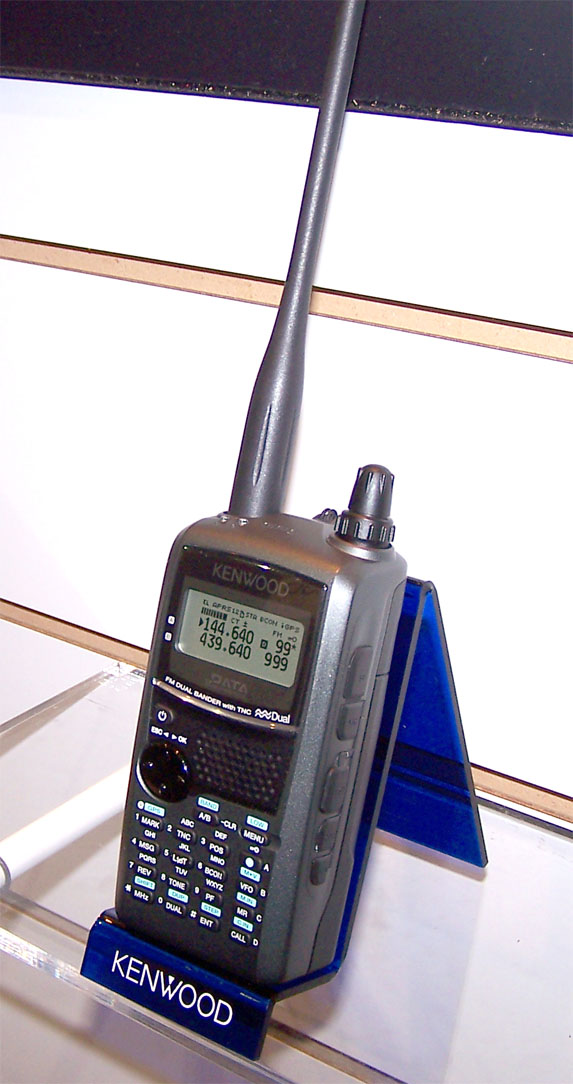
| WA8LMF Home Page | Main Ham Radio Page | Main APRS Page | Updated 06 January 2011 |
The photos below, of the prototype of the new TH-D72 dual-band APRS hand-held radio, were taken in May 2010 at the Dayton Hamvention. This radio is the long-awaited successor to the discontinued TH-D7. The new radio became available in late 2010.
The relentless progression of Moore's Law (that posits that the number of transistors in processor and memory chips doubles every 18-24 months) is dramatically evident. Although the radio superficially looks like the TH-D7, the number of functions, capabilities and memory capacities has increased dramatically. For example, the built-in GPS has a 5,000-point log file in the radio's memory that can record your movements, even without transmitting over-the-air APRS posits.
The TH-D72 features a built-in GPS receiver (the GPS patch antenna in in the slight hump between the whip and the volume control), but the the classic 2.5mm stereo mini-jack for an external serial GPS remains. This allows you to continue to use RS-232 serial GPS devices like the GeoSat AVmap-5 mapping GPS as both a GPS source and a display. The GPS port can also accept certain Peet Bros or Davis weather stations as input.
The TH-D72 has a "GPS-only" mode with the radio part
turned off, that allows you to use the unit like a hand-held GPS (such as a
Garmin eTrex) with track log and waypoints for extended periods. Specs say
GPS-only battery drain is only 60mA.
An feature of the built-in GPS log is to the ability to only record the points
that were also beaconed over RF. This could have some interesting uses in
evaluating APRS coverage, by comparing the points logged locally with the points
that made it to the APRS-IS after an outing.
The computer interface port (that was a classic RS-232 port on the TH-D7) is now a mini-USB port like the ones on many cell phones, digital cameras, and Garmin car GPS units. Actually it is a serial port internally, converted to USB with a chip similar to the ones on the typical USB<-->serial adapter-cable "dongles". The only difference is that (like many current "USB" GPS devices) the conversion is inside the device instead of in a cable. This USB interface replaces the "main" serial port of the old TH-D7.
Like the usual dongles, you install a driver in the Windows PC to convert the USB connection back to a virtual COM port so that serial-port-oriented APRS programs and radio programming utilities can still "think" they are using a serial connection.
However, for some reason, Kenwood didn't use the common
Prolific or FDTI USB<-->serial conversion chips widely used in other
USB<-->serial cables and devices like the TNC-X, the Pfranc USB<-->serial
cable, Pharos/Microsoft USB GPS units, etc. If you have ever used one of these
devices, you probably already have the drivers for one or the other of these two
chips already on your system. Instead, Kenwood opted to go with the far
less common Silicon Labs CP210x USB to UART Bridge chip, resulting in the need
to install yet another USB<-->Virtual Com Port driver. Details here:
<http://www.silabs.com/products/mcu/pages/usbtouartbridgevcpdrivers.aspx>
Like most modern portable electronic gadgets, the radio is provided with a lithium-ion battery pack rather than a nickel-hydride pack like earlier models. An optional battery pack holds 6 AAA-sized batteries (not AAs) !! Outrageous since you pay about the same for AAs and AAAs, but get at least twice the energy in a AA..... [Here's hoping Batteries America quickly comes out with a third-party pack for AAs.]
The TH-D72 supports both proportional pathing (more frequent beacons on short paths and less frequent beacons on longer paths), and smart beaconing.
The currrent Kenwood "Memory Control Program" being
offered for this radio is the MCP-4A software intended for the non-APRS
predecessor radio. You can edit memory frequencies, PL codes, etc, but there
is NO support for any of the APRS features in the memory config program (unlike
the software for the TH-D7).
Manuals for this new radio can now be downloaded from the Kenwood website at:
http://manual.kenwood.com/en_contents/attachDownload/7736/
Small "Getting Started" manual - (1.3MB)
http://manual.kenwood.com/en_contents/attachDownload/7742/
Large badly-organized capture of multiple
PDF files originally on a CD-ROM packed with the radio, into a single large PDF.
- (About 6.5MB)
Finally, didn't anyone in the Kenwood USA organization proof-read the manuals??? The manual is full of mangled Japanese "Ingris" such as these:
From page GPS-3 in the large PDF:
"Battery Saver (GPS Save)
This function will turn the GPS power source Off
after the programmed timer expires if position data
is not determined during the maximum catching time
(approximately 5 minutes). To prevent unnecessary
battery consumption, when there are many reception
satellites, the GPS is stabilized and position data can
be determined, the GPS power source repeatedly turns
On and Off."
From page PACKET-1:
"PACKET OPERATION
Connect this transceiver to your personal computer via a Terminal Node Controller (TNC)."
Huh?? A radio with a built-in TNC needs another TNC to
connect to a computer??! [I assume that what they really meant to say was
"Connect this transceiver to your radio via the built-in TNC."]
On page APRS-15 of the large PDF, in the list of
available APRS symbols, the train symbol is labeled "REILROAD ENGIN". Well, I
guess it's approximately phonetic in English....
w

